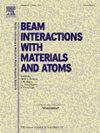Irradiation-induced formation of G-phase precipitates and M2X carbides in self-ion irradiated HT-9
IF 1.4
3区 物理与天体物理
Q3 INSTRUMENTS & INSTRUMENTATION
Nuclear Instruments & Methods in Physics Research Section B-beam Interactions With Materials and Atoms
Pub Date : 2025-04-05
DOI:10.1016/j.nimb.2025.165703
引用次数: 0
Abstract
Ferritic-martensitic steels with high chromium content are a promising material group for advanced nuclear systems due to their high temperature strength and good irradiation tolerance. HT-9 is an optimized and often-studied alloy in this group, but additional studies are required on its radiation response under extreme conditions to be experienced in various types of nuclear reactors, especially with respect to phase stability under irradiation. Self-ion irradiation of HT-9 by 5 MeV Fe ions was used to simulate neutron-induced behavior reaching peak doses of 100 and 300 dpa at temperatures ranging from 450 to 550 °C. M23C6 carbides that existed prior to irradiation were found to remain stable under all examined irradiation conditions. As irradiation progressed at 450 and 500 °C, however, formation of spherical-like G-phase precipitates and needle-like M2X carbides was observed. G-phase precipitates were found to be enriched in Ni, Si, and Mn, and show no interface segregation, whereas needle-like M2X carbides were rich in Cr and Mo and clearly displayed interface segregation of Ni and Si. M2X carbide formation is believed to be assisted by vacancies, while G-phase precipitation is thought to be assisted by interstitials. This difference in defect-mediated formation leads to a difference in distribution with depth. M2X carbides are distributed over shallower depths than that of G-phase precipitates, consistent with defect imbalance predictions that consider the influence of the injected interstitial effect.
自离子辐照HT-9中g相沉淀和M2X碳化物的辐照诱导形成
高铬铁素体-马氏体钢具有高温强度高、耐辐照性能好等优点,在先进核系统中具有广阔的应用前景。HT-9是这一类合金中经过优化并经常被研究的一种合金,但需要对其在各种类型核反应堆中经历的极端条件下的辐射响应进行额外的研究,特别是在辐照下的相稳定性方面。采用5 MeV Fe离子自离子辐照HT-9,模拟了在450 ~ 550℃温度范围内达到峰值剂量100和300 dpa的中子诱导行为。发现辐照前存在的M23C6碳化物在所有检测的辐照条件下都保持稳定。然而,在450和500℃的辐照下,观察到球形g相沉淀和针状M2X碳化物的形成。g相析出物富集Ni、Si和Mn,且无界面偏析;针状M2X碳化物富集Cr和Mo,且Ni和Si界面偏析明显。M2X碳化物的形成被认为是由空位辅助的,而g相的沉淀被认为是由间隙辅助的。这种缺陷介导地层的差异导致了随深度分布的差异。与g相相相比,M2X碳化物分布在较浅的深度上,这与考虑注入间隙效应影响的缺陷不平衡预测相一致。
本文章由计算机程序翻译,如有差异,请以英文原文为准。
求助全文
约1分钟内获得全文
求助全文
来源期刊
CiteScore
2.80
自引率
7.70%
发文量
231
审稿时长
1.9 months
期刊介绍:
Section B of Nuclear Instruments and Methods in Physics Research covers all aspects of the interaction of energetic beams with atoms, molecules and aggregate forms of matter. This includes ion beam analysis and ion beam modification of materials as well as basic data of importance for these studies. Topics of general interest include: atomic collisions in solids, particle channelling, all aspects of collision cascades, the modification of materials by energetic beams, ion implantation, irradiation - induced changes in materials, the physics and chemistry of beam interactions and the analysis of materials by all forms of energetic radiation. Modification by ion, laser and electron beams for the study of electronic materials, metals, ceramics, insulators, polymers and other important and new materials systems are included. Related studies, such as the application of ion beam analysis to biological, archaeological and geological samples as well as applications to solve problems in planetary science are also welcome. Energetic beams of interest include atomic and molecular ions, neutrons, positrons and muons, plasmas directed at surfaces, electron and photon beams, including laser treated surfaces and studies of solids by photon radiation from rotating anodes, synchrotrons, etc. In addition, the interaction between various forms of radiation and radiation-induced deposition processes are relevant.

 求助内容:
求助内容: 应助结果提醒方式:
应助结果提醒方式:


